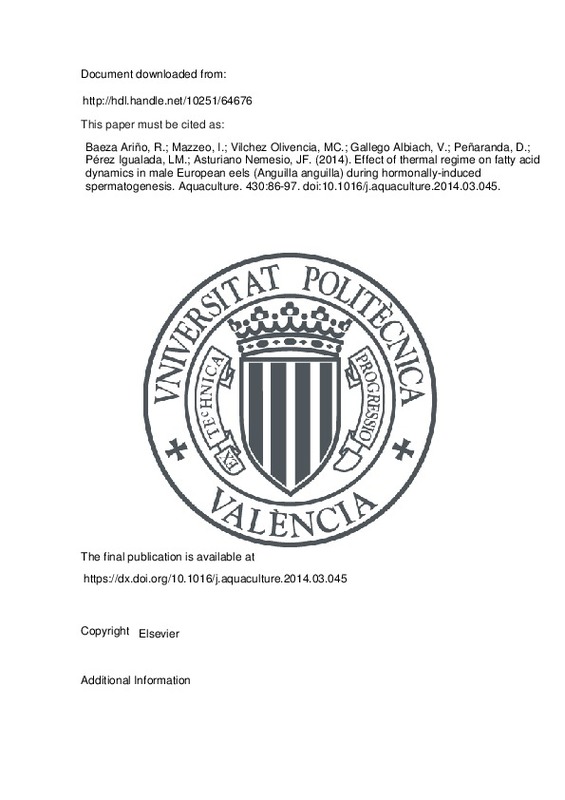Baeza Ariño, R.; Mazzeo, I.; Vilchez Olivencia, MC.; Gallego Albiach, V.; Peñaranda, D.; Pérez Igualada, LM.; Asturiano Nemesio, JF. (2014). Effect of thermal regime on fatty acid dynamics in male European eels (Anguilla anguilla) during hormonally-induced spermatogenesis. Aquaculture. 430:86-97. https://doi.org/10.1016/j.aquaculture.2014.03.045
Por favor, use este identificador para citar o enlazar este ítem: http://hdl.handle.net/10251/64676
|
Título:
|
Effect of thermal regime on fatty acid dynamics in male European eels (Anguilla anguilla) during hormonally-induced spermatogenesis
|
|
Autor:
|
Baeza Ariño, Rosa
Mazzeo, Ilaria
Vilchez Olivencia, Maria Carmen

 Gallego Albiach, Victor
Gallego Albiach, Victor

 Peñaranda, D.S.
Peñaranda, D.S.

 Pérez Igualada, Luz María
Pérez Igualada, Luz María

 Asturiano Nemesio, Juan Francisco
Asturiano Nemesio, Juan Francisco
|
|
Entidad UPV:
|
Universitat Politècnica de València. Instituto de Ciencia y Tecnología Animal - Institut de Ciència i Tecnologia Animal
Universitat Politècnica de València. Departamento de Ciencia Animal - Departament de Ciència Animal
|
|
Fecha difusión:
|
|
|
Resumen:
|
[EN] Little is known about the role of fat and fatty acids in European eel spermatogenesis. The aim of this research was
to study the changes in fat content and to carry out a quantitative analysis of the fatty acid ...[+]
[EN] Little is known about the role of fat and fatty acids in European eel spermatogenesis. The aim of this research was
to study the changes in fat content and to carry out a quantitative analysis of the fatty acid composition of the
muscle, liver and gonad of European male eels during hormonally induced sexual maturation. Three different
thermal regimes were used (two variable: T10 and T15; and one constant: T20) to replicate the changes in temperature
that these fish experience during their transoceanic reproductive migration. Spermatogenesis was
reached earlier in treatment T20, suggesting that spermatogenesis in the European eel is closely regulated by
water temperature. Although eels lose body mass due to the period of fasting that accompanies gonadal growth,
no significant changes were found in the fat and fatty acid content of the muscle during the experimental period.
With regard to the liver, the levels of palmitic, eicosapentaenoic (EPA) and docosahexaenoic (DHA) acids
increased significantly at the start of the spermiation process in all the thermal treatments.
In the testis, levels of EPA, arachidonic acid (ARA) and DHA remained constant during the maturation process
whereas the levels of the rest of the fatty acids decreased significantly. The stability of the ARA and EPA levels
in the testis may have a physiological significance, whereas the stability of the DHA levels may have a structural
significance. The results suggest that the progression of spermiation is influenced by water temperature and
demonstrate the importance of EPA, ARA and DHA in European eel reproduction. This study demonstrates that
complementary research focusing on the lipid composition of commercial diets could improve the sperm quality
of this species.
[-]
|
|
Palabras clave:
|
Muscle
,
Liver
,
Gonad
,
Spermatogenesis
,
Diets
,
PUFA
,
Eel
|
|
Derechos de uso:
|
Reserva de todos los derechos
|
|
Fuente:
|
Aquaculture. (issn:
0044-8486
) (eissn:
1873-5622
)
|
|
DOI:
|
10.1016/j.aquaculture.2014.03.045
|
|
Editorial:
|
Elsevier
|
|
Versión del editor:
|
https://dx.doi.org/10.1016/j.aquaculture.2014.03.045
|
|
Código del Proyecto:
|
info:eu-repo/grantAgreement/MICINN//PTA2011-4948-I/ES/PTA2011-4948-I/
info:eu-repo/grantAgreement/EC//245257
info:eu-repo/grantAgreement/UPV//PAID-2011-S2-02-6521/
|
|
Agradecimientos:
|
Funded by the European Community's 7th Framework Programme under the Theme 2 "Food, Agriculture and Fisheries, and Biotechnology", grant agreement no. 245257 (PRO-EEL). Victor Gallego, Ilaria Mazzeo and M. Carmen Vilchez ...[+]
Funded by the European Community's 7th Framework Programme under the Theme 2 "Food, Agriculture and Fisheries, and Biotechnology", grant agreement no. 245257 (PRO-EEL). Victor Gallego, Ilaria Mazzeo and M. Carmen Vilchez had predoctoral grants from the Spanish Ministry of Science and Innovation (MICINN), Generalitat Valenciana, and UPV PAID Programme (2011-S2-02-6521), respectively. David S. Penaranda was supported by a contract co-financed by MICINN and UPV (PTA2011-4948-I). Rosa Baeza was supported by contract financed by PRO-EEL. The authors want to thank Vicente Javier Moya Salvador for his technical assistance with gas chromatography analyses.
[-]
|
|
Tipo:
|
Artículo
|







![[Cerrado]](/themes/UPV/images/candado.png)


